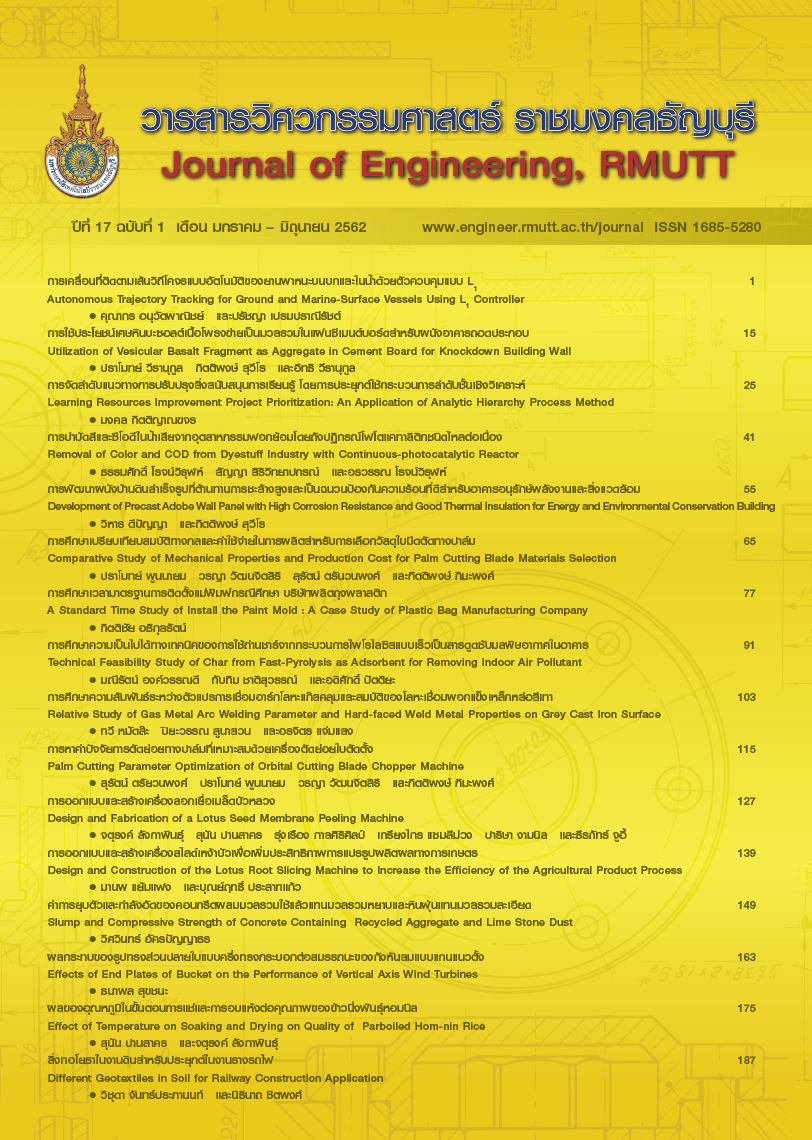Different Geotextiles in Soil for Railway Construction Application
Main Article Content
Abstract
This research aimed to study the use of different geotextiles in soil for railway construction application. Three nonwovens were produced by carding followed by needlepunching and then were compared to commercial geotextile. The fabric weight of three nonwovens was around 200 to 600 gram per square meter (gsm) and the thickness of them was typically 2 to 7 millimeter (mm). Nonwoven having the heaviest in fabric weight of 609.8 gsm and the thickest of 6.76 mm exhibited the highest in both of tensile strength and bursting strength but had the slightest in hydraulic properties both of air permeability and water permeability. In addition, three nonwovens and the commercial geotextile were performed in a laboratory California Bearing Ratio (CBR) test to investigate the behavior of reinforced soil with different materials. The results showed that the stress of each penetration of soil was not improved with the inclusion of each material. However, CBR value of the soil with the heaviest nonwoven were higher than that of the soil with commercial geotextile about 87%. Therefore, the introduction of the heaviest nonwoven reinforcement in soil enhanced the bearing capacity compared to the placing of commercial geotextile in soil.
Article Details
The manuscript, information, content, picture and so forth which were published on Frontiers in engineering innovation research has been a copyright of this journal only. There is not allow anyone or any organize to duplicate all content or some document for unethical publication.
References
Hemmachandra K. Technical Textiles. Bangkok: Offset Creations Co.,Ltd. 2006. (in Thai)
Koerner RM. Designing with geosynthetics Vol. 1. 6th ed. Kentucky: Xlibris Corporation. 2014.
Koerner RM. Chapter 11 geotextile used in separation. In: Koerner RM, editor. Geotextile from Design to Applications. Cambridge: Woodhead Publishing. 2016. p. 241–256.
Christopher BR. Chapter 14 geotextiles used in reinforcing paved and unpaved roads and railroads. In: Koerner RM, editor. Geotextile from Design to Applications. Cambridge: Woodhead Publishing. 2016. p. 305–335.
Rail Design Support Manual. cited 2016 October 21. Available from www.geofabrics.com
Ashpiz ES, Diederich R, Koslowski C. The use of spunbonded geotextile in railway track renewal St.Petersburg-Moscow. Proceeding of 7th International Conference on Geosynthetics, Nice, France, 2002. p. 1173-1176.
TenCate Polyfelt® in Dutch Rail Renovation. cited 2016 January 5. Available from www.tencate.com/txtures/winter-2011/TenCate-Polyfelt-in-Dutch-rail-renovation.aspx
Polyfelt® TS – Separation & Filtration Nonwovens. cited 2016 January 5. Available from https://www.buildsite.
com/pdf/tcmirafi/TenCate-Polyfelt-TS-Product-Data-1540984.pdf
Adam C, Apraku E, Opuku-Boahen R. Effect of triaxial geogrid reinforcement on CBR strength of natural gravel soil for road pavements. Journal of Civil Engineering Research. 2015;5(1): 45-51.
Çinçik E, ,Koç E. An analysis on air permeability of polyester/viscose blended needle-punched nonwovens. Text. Res. J. 2011;82(5): 430-442.
Kumar PS, Rajkumar R. Effect of geotextile on CBR strength of unpaved road with soft subgrade. Electronic Journal of Geotechnical Engineering. 2012;17: 1355-1363.
Kumar PS, Devi SP. Effect of needle punched nonwoven coir and jute geotextile on CBR strength of soft subgrade. ARPN Journal of Engineering and Applied Sciences. 2011;6(11): 114-116.
Naeini SA, Mirzakhanlari M. The effect of geotextile grading on the bearing ratio of granular soils. Electronic Journal of Geotechnical Engineering. 2008;13: 1-10.


